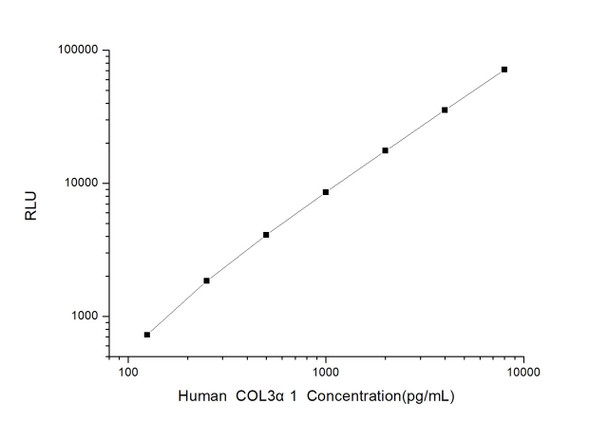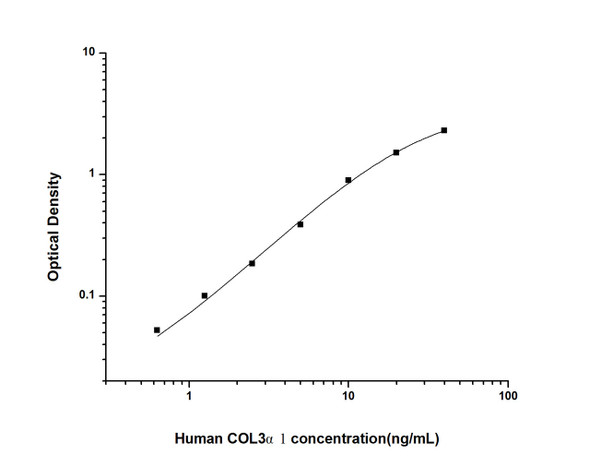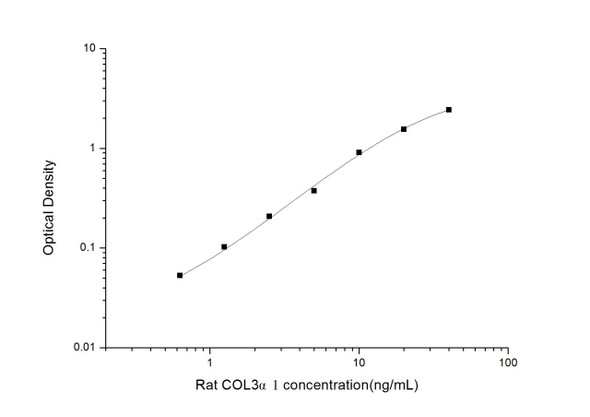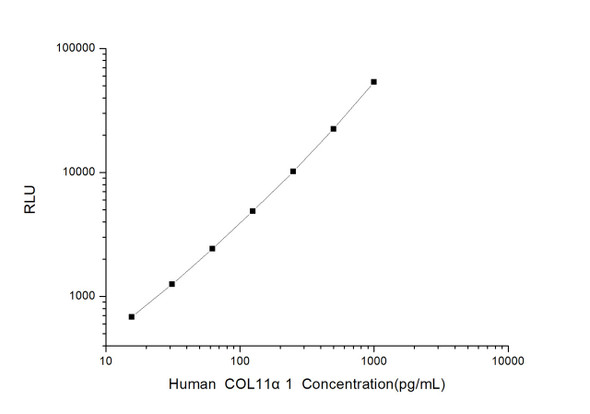Human Cell Biology ELISA Kits 3
Human COL3 alpha1 (Collagen Type III Alpha 1) CLIA Kit (HUES00488)
- SKU:
- HUES00488
- Product Type:
- ELISA Kit
- ELISA Type:
- CLIA Kit
- Size:
- 96 Assays
- Sensitivity:
- 75pg/mL
- Range:
- 125-8000pg/mL
- ELISA Type:
- Sandwich
- Reactivity:
- Human
- Sample Type:
- Serum, plasma and other biological fluids
- Research Area:
- Cell Biology
Description
| Assay type: | Sandwich |
| Format: | 96T |
| Assay time: | 4.5h |
| Reactivity: | Human |
| Detection method: | Chemiluminescence |
| Detection range: | 125.00-8000 pg/mL |
| Sensitivity: | 75.00 pg/mL |
| Sample volume: | 100µL |
| Sample type: | Serum, plasma and other biological fluids |
| Repeatability: | CV < 15% |
| Specificity: | This kit recognizes Human COL3 alpha1 in samples. No significant cross-reactivity or interference between Human COL3 alpha1 and analogues was observed. |
This kit uses Sandwich-CLIA as the method. The micro CLIA plate provided in this kit has been pre-coated with an antibody specific to Human COL3 alpha1. Standards or samples are added to the appropriate micro CLIA plate wells and combined with the specific antibody. Then a biotinylated detection antibody specific for Human COL3 alpha1 and Avidin-Horseradish Peroxidase (HRP) conjugate are added to each micro plate well successively and incubated. Free components are washed away. The substrate solution is added to each well. Only those wells that contain Human COL3 alpha1, biotinylated detection antibody and Avidin-HRP conjugate will appear fluorescence. The Relative light unit (RLU) value is measured spectrophotometrically by the Chemiluminescence immunoassay analyzer. The RLU value is positively associated with the concentration of Human COL3 alpha1. The concentration of Human COL3 alpha1 in the samples can be calculated by comparing the RLU of the samples to the standard curve.
| UniProt Protein Function: | CO3A1: Collagen type III occurs in most soft connective tissues along with type I collagen. Defects in COL3A1 are a cause of Ehlers-Danlos syndrome type 3 (EDS3); also known as benign hypermobility syndrome. EDS is a connective tissue disorder characterized by hyperextensible skin, atrophic cutaneous scars due to tissue fragility and joint hyperlaxity. EDS3 is a form of Ehlers-Danlos syndrome characterized by marked joint hyperextensibility without skeletal deformity. Defects in COL3A1 are the cause of Ehlers-Danlos syndrome type 4 (EDS4). EDS is a connective tissue disorder characterized by hyperextensible skin, atrophic cutaneous scars due to tissue fragility and joint hyperlaxity. EDS4 is the most severe form of the disease. It is characterized by the joint and dermal manifestations as in other forms of the syndrome, characteristic facial features (acrogeria) in most patients, and by proneness to spontaneous rupture of bowel and large arteries. The vascular complications may affect all anatomical areas. Defects in COL3A1 are a cause of susceptibility to aortic aneurysm abdominal (AAA). AAA is a common multifactorial disorder characterized by permanent dilation of the abdominal aorta, usually due to degenerative changes in the aortic wall. Histologically, AAA is characterized by signs of chronic inflammation, destructive remodeling of the extracellular matrix, and depletion of vascular smooth muscle cells. Belongs to the fibrillar collagen family. 2 isoforms of the human protein are produced by alternative splicing. |
| UniProt Protein Details: | Protein type:Secreted; Motility/polarity/chemotaxis; Extracellular matrix; Secreted, signal peptide; Cell adhesion Chromosomal Location of Human Ortholog: 2q31 Cellular Component: extracellular matrix; extracellular space; endoplasmic reticulum lumen; extracellular region; collagen type III Molecular Function:integrin binding; protein binding; extracellular matrix structural constituent; platelet-derived growth factor binding; metal ion binding; SMAD binding Biological Process: integrin-mediated signaling pathway; skin development; platelet activation; axon guidance; receptor-mediated endocytosis; extracellular matrix organization and biogenesis; collagen fibril organization; wound healing; heart development; cell-matrix adhesion; negative regulation of immune response; positive regulation of Rho protein signal transduction; collagen catabolic process; extracellular matrix disassembly; response to radiation; gut development; response to mechanical stimulus; response to cytokine stimulus; transforming growth factor beta receptor signaling pathway; fibril organization and biogenesis; cerebral cortex development; peptide cross-linking; skeletal development; aging Disease: Ehlers-danlos Syndrome, Type Iv, Autosomal Dominant; Ehlers-danlos Syndrome, Type Iii |
| NCBI Summary: | This gene encodes the pro-alpha1 chains of type III collagen, a fibrillar collagen that is found in extensible connective tissues such as skin, lung, uterus, intestine and the vascular system, frequently in association with type I collagen. Mutations in this gene are associated with Ehlers-Danlos syndrome types IV, and with aortic and arterial aneurysms. Two transcripts, resulting from the use of alternate polyadenylation signals, have been identified for this gene. [provided by R. Dalgleish, Feb 2008] |
| UniProt Code: | P02461 |
| NCBI GenInfo Identifier: | 124056490 |
| NCBI Gene ID: | 1281 |
| NCBI Accession: | P02461. 4 |
| UniProt Secondary Accession: | P02461,P78429, Q15112, Q16403, Q53S91, Q541P8, Q6LDB3 Q6LDJ2, Q6LDJ3, Q7KZ56, D2JYH5, D3DPH4, |
| UniProt Related Accession: | P02461 |
| Molecular Weight: | |
| NCBI Full Name: | Collagen alpha-1(III) chain |
| NCBI Synonym Full Names: | collagen, type III, alpha 1 |
| NCBI Official Symbol: | COL3A1 |
| NCBI Official Synonym Symbols: | EDS4A |
| NCBI Protein Information: | collagen alpha-1(III) chain; collagen alpha-1(III) chain; collagen, fetal; alpha1 (III) collagen; Ehlers-Danlos syndrome type IV, autosomal dominant |
| UniProt Protein Name: | Collagen alpha-1(III) chain |
| Protein Family: | Collagen |
| UniProt Gene Name: | COL3A1 |
| UniProt Entry Name: | CO3A1_HUMAN |
As the RLU values of the standard curve may vary according to the conditions of the actual assay performance (e. g. operator, pipetting technique, washing technique or temperature effects), the operator should establish a standard curve for each test. Typical standard curve and data is provided below for reference only.
| Concentration (pg/mL) | RLU | Average | Corrected |
| 8000 | 71330 71548 | 71439 | 71418 |
| 4000 | 34862 36134 | 35498 | 35477 |
| 2000 | 18829 16279 | 17554 | 17533 |
| 1000 | 8300 8876 | 8588 | 8567 |
| 500 | 4116 4098 | 4107 | 4086 |
| 250 | 1881 1853 | 1867 | 1846 |
| 125.00 | 717 777 | 747 | 726 |
| 0 | 21 21 | 21 | -- |
Precision
Intra-assay Precision (Precision within an assay): 3 samples with low, mid range and high level Human COL3 alpha1 were tested 20 times on one plate, respectively.
Inter-assay Precision (Precision between assays): 3 samples with low, mid range and high level Human COL3 alpha1 were tested on 3 different plates, 20 replicates in each plate.
| Intra-assay Precision | Inter-assay Precision | |||||
| Sample | 1 | 2 | 3 | 1 | 2 | 3 |
| n | 20 | 20 | 20 | 20 | 20 | 20 |
| Mean (pg/mL) | 426.10 | 846.34 | 2747.87 | 430.25 | 904.09 | 2729.01 |
| Standard deviation | 46.02 | 97.08 | 205.54 | 44.27 | 86.61 | 229.51 |
| C V (%) | 10.80 | 11.47 | 7.48 | 10.29 | 9.58 | 8.41 |
Recovery
The recovery of Human COL3 alpha1 spiked at three different levels in samples throughout the range of the assay was evaluated in various matrices.
| Sample Type | Range (%) | Average Recovery (%) |
| Serum (n=5) | 84-98 | 91 |
| EDTA plasma (n=5) | 91-103 | 97 |
| Cell culture media (n=5) | 97-111 | 105 |
Linearity
Samples were spiked with high concentrations of Human COL3 alpha1 and diluted with Reference Standard & Sample Diluent to produce samples with values within the range of the assay.
| Serum (n=5) | EDTA plasma (n=5) | Cell culture media (n=5) | ||
| 1:2 | Range (%) | 102-119 | 93-108 | 87-103 |
| Average (%) | 109 | 100 | 94 | |
| 1:4 | Range (%) | 101-118 | 86-97 | 95-106 |
| Average (%) | 109 | 92 | 100 | |
| 1:8 | Range (%) | 94-108 | 85-97 | 90-105 |
| Average (%) | 101 | 91 | 96 | |
| 1:16 | Range (%) | 94-105 | 83-95 | 93-106 |
| Average (%) | 99 | 90 | 98 |
An unopened kit can be stored at 4°C for 1 month. If the kit is not used within 1 month, store the items separately according to the following conditions once the kit is received.
| Item | Specifications | Storage |
| Micro CLIA Plate(Dismountable) | 8 wells ×12 strips | -20°C, 6 months |
| Reference Standard | 2 vials | |
| Concentrated Biotinylated Detection Ab (100×) | 1 vial, 120 µL | |
| Concentrated HRP Conjugate (100×) | 1 vial, 120 µL | -20°C(shading light), 6 months |
| Reference Standard & Sample Diluent | 1 vial, 20 mL | 4°C, 6 months |
| Biotinylated Detection Ab Diluent | 1 vial, 14 mL | |
| HRP Conjugate Diluent | 1 vial, 14 mL | |
| Concentrated Wash Buffer (25×) | 1 vial, 30 mL | |
| Substrate Reagent A | 1 vial, 5 mL | 4°C (shading light) |
| Substrate Reagent B | 1 vial, 5 mL | 4°C (shading light) |
| Plate Sealer | 5 pieces | |
| Product Description | 1 copy | |
| Certificate of Analysis | 1 copy |
- Set standard, test sample and control (zero) wells on the pre-coated plate and record theirpositions. It is recommended to measure each standard and sample in duplicate. Note: addall solutions to the bottom of the plate wells while avoiding contact with the well walls. Ensuresolutions do not foam when adding to the wells.
- Aliquot 100µl of standard solutions into the standard wells.
- Add 100µl of Sample / Standard dilution buffer into the control (zero) well.
- Add 100µl of properly diluted sample (serum, plasma, tissue homogenates and otherbiological fluids. ) into test sample wells.
- Cover the plate with the sealer provided in the kit and incubate for 90 min at 37°C.
- Aspirate the liquid from each well, do not wash. Immediately add 100µL of BiotinylatedDetection Ab working solution to each well. Cover the plate with a plate seal and gently mix. Incubate for 1 hour at 37°C.
- Aspirate or decant the solution from the plate and add 350µL of wash buffer to each welland incubate for 1-2 minutes at room temperature. Aspirate the solution from each well andclap the plate on absorbent filter paper to dry. Repeat this process 3 times. Note: a microplatewasher can be used in this step and other wash steps.
- Add 100µL of HRP Conjugate working solution to each well. Cover with a plate seal andincubate for 30 min at 37°C.
- Aspirate or decant the solution from each well. Repeat the wash process for five times asconducted in step 7.
- Add 100µL of Substrate mixture solution to each well. Cover with a new plate seal andincubate for no more than 5 min at 37°C. Protect the plate from light.
- Determine the RLU value of each well immediately.






